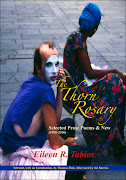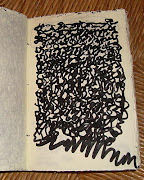I thought I had it all figured out, you see, about this Friday's (today's) reading/presentation at
Small Press Traffic. For the past couple of weeks, I had planned to present poems contextualized within a discussion of how Western critics have described my work, versus what I feel now to be the more truthful underlying aspect to what I've done as a poet: IKSP (Indigenous Knowledge Systems and Practices). I thought that a discourse on the Western
gaze might be a doorway into SPT's themes of "empires" and "community" which my talk is supposed to address.
But whenever I tried to prepare for it in the last few days, something just didn't feel right. Again, it all just seemed too much about
Me, Myself and I. Finally, I got the sign -- an article in
Wednesday's New York Times about Russian orphanage life, a matter raised by the prior news of a
U.S.-American Mom recently returning her son to Russia where she'd adopted him. Like many who've gone through adoption (especially international adoption or "older" child adoption, both of which I've done), I've not stopped pondering how Torry-Ann Hansen of Tennessee sent her adopted 7-year-old son Artem Saveliev back home to Russia by himself with a note demanding the adoption be annulled.
In fact, as soon as I heard the news last month, I immediately thought to post an article on my other blog,
The Blind Chatelaine's Keys, about how wonderfully my son Michael is doing (I adopted Michael from Colombia last year when he was 13; he turned 14 in March and has been in our family now for just over a year). In thinking to do a blog post in response to Torry-Ann Hansen's failed adoption, I had planned to make sure to include key phrases for Googling purposes like "Hansen adoption," "Russian orphan," "international adoption," etc. For I had wanted that blogged article about Michael's successful integration into a new (our) family, new school, new country, new language and so on to be an internet antidote to the coverage of the Hansen family difficulties. Why? Because estimates reach as high as 200 million for orphans worldwide, and the most difficult category for its members to get adopted are "older boys."
"Older", here, can mean four years or older or, for the context of the program I went through to adopt my son, seven years and older. It's horrible -- it's like, in some circles, if a boy gets past seven--or four!--years of age, people give up on them.... Michael was 13 when I adopted him--we were the first ever to express adoption interest in him (he'd already been in an orphanage for about six years); if things had not worked out with the adoption, the odds are that he would have stayed in the orphanage until he aged out of the system.
There clearly is a lot of fear and misconception out there about adopting older children (and specifically older boys), and while I've long blathered as a proud Mama over
Michael's achievements since he joined our family, I didn't write the Hansen-reaction post. Because before I successfully adopted my son, I went through earlier attempts to adopt...and failed.
My first failed adoption effort is detailed in a "haybun" entitled "Looking for M." that I wrote on the plane ride from Bogota to San Francisco, published in
The Blind Chatelaine's Keys (later reprinted in
THE THORN ROSARY). Note what this "blurb" partly says:
“‘Looking for M.' is not just deeply moving but also educational about one of the most complicated difficulties in adoption attempts: reactive attachment disorder. Eileen Tabios reveals her psychic wounds to educate the public about the potentially dire consequences of orphanhood. M.'s story is the story of so many orphans whose interior lives are often invisible. Ms. Tabios gives them a voice through poems I read over and over, saddened that the emotions I feel become physical.”
—Sherrell J. Goolsby, Executive Director of World Child International
I don't know if the Tory-Ann Hansen matter involves a child with reactive attachment disorder, but it's clear that there were attachment problems -- my empathy with any parent in that position prevented me earlier from writing about the Hansen adoption. For while I think the decision to put a 7-year-old on a plane back to another country by himself is majorly knuckle-headed, I also know that most people interested in adoptions are not sufficiently trained or sensitized to deal with many of the issues that accompany children who've spent significant periods of time in institutions. And, it's not unusual in international adoption cases that a child's background may not be fully known or shared with adopting parents. This doesn't mean that older-child adoptions should not occur;
the majority of adoptions succeed! -- but it does mean that bureaucracies worldwide involved in finding families for orphans need to do a significantly better job in preparing participants. And those interested in being adoptive parents need to get with the preparation program and not simply believe
Love will conquer All.
The preparation of the adopting families is often given short shrift. The formal preparation that I was obliged to do in order to adopt (e.g. ten hours for an internet course) was inadequate. After my failed adoption attempts, I prepared myself -- in part by reading every single adoption related book I could find. That research was critical preparation because, later, when some problems came up that were to be expected of a child with an institutionalized background, our family was prepared to deal with them. The media coverage of the Tory-Ann Hansen failed adoption seems to indicate that the mother was not prepared to address the problems that surfaced.
Regardless of how many adoptions occur, no matter how much attention is raised by celebrities ranging over Angelina Jolie to Sandra Bullock, we are not anywhere near addressing the huge global humanitarian catastrophe posed by neglected orphans. But the answer is not simply placing children in families (though that step already is so difficult). As with many issues, education needs to occur. The complications related to raising formerly institutionalized children does not mean these children are not adoptable and can't thrive in new families. But there is a spectrum of complications with these children, and the more that potential parents are prepared, the more likely the adoption will succeed.
The social effects of neglecting this issue is huge -- one adoption counselor I met during my process said a social worker once told her, "In the orphanages, we are breeding millions of serial murderers." The quote, though perhaps exagerrated bears a kernel of truth: it relates to how some (some not all) children raised without family, raised in institutional settings, sometimes fail to develop their ability to attach to other people which, in turn, can have psychopathic results.
I obviously can't summarize all the issues in this blog post, but I will say that addressing this as part of my SPT reading (partly with readings from "Looking for M.") would seem to be more
"moral[ly] imperative" (ref. prior post) than discussing how critics in the past have responded to my poems. As regards community, the plight of orphans requires no less than a global village approach. As regards empire,
everything relates to empire; the article on Russian orphanages offers just one deplorable example:
The Russian government spends roughly $3 billion annually on orphanages and similar facilities, creating a system that is an important source of jobs and money on the regional level — and a target for corruption.
As a result, it is in the interests of regional officials to maintain the flow of children to orphanages and then not to let them leave, child welfare experts said. When adoptions are permitted, families, especially foreign families, have to pay large fees and navigate a complex bureaucracy.
“The system has one goal, which is to preserve itself,” said Boris L. Altshuler, chairman of Right of the Child, an advocacy group in Moscow, and a member of a Kremlin advisory group.
“That is why the process of adoption in Russia is like going through the circles of hell,” he said. “The system wants these children to remain orphans.”
*****
Meanwhile, yes -- Google me through these phrases: "adoption", "Hansen adoption," "older child adoption", "Russian orphan," "international adoption," among others. And when you get to this site, let me tell you about my son Michael -- someone who once was considered by some people around him to be "a lost cause":
Adopted at age 13. At the time of his adoption, he was only in 4th grade in an orphanage one-room school situation in Colombia. Six months later, he is slotted into 7th grade (because of his age) in one of California's top public schools. At said excellent public school, he swiftly became honor roll. In less than a year, he is communicating well in English. He's developed into a reader--he reads himself to sleep every night. Last quarter, he received three top-of-his class certificates in addition to his A-average Honor Roll certificate.
In sports, he was on a championship soccer team, as well as does well in other sports new to him, from skiing to tennis to swimming. He also just received an awards certificate in P.E.--he can run a mile in just over six minutes.
His hobbies include building model rockets, photography, drawing (he's an excellent artist), bee-keeping, skateboarding, movies and exploring the night-sky through telescopes.
He knows his manners, is engaged with people, and has developed a witty sense of humor. He loves our two dogs and two cats -- when our cat was injured, he helped take care of her for six weeks so that, by the end of the healing process, the cat (which formerly was too skittish to approach him) was fully bonded with him.
He is sensitive and compassionate--today, he was telling me about seeing a group of drivers from a Ferrari rally, and thinking that those drivers need to have spent all the money acquiring their cars for "better" reasons, like solving the plight of poor people. When he's helped me bring food to the local food pantry, I can see his eyes observing, assessing, and ...
caring, even as it also bolsters his fortitude for making something of himself (which he defines for now as attending college).
He wrote his first English-language poem recently and, as I note in my unbiased literary critique (feel free to go to link for the whole thing),
"A close reader no doubt would glean the expansiveness of this 14-year-old’s world view—this poem is not written from [just] a personal 'I'." I could go on. The point is: if you're prepared--and you
can be prepared,
OLDER CHILD ADOPTION WORKS.I've long felt there were two demographically-created dots that needed more connections: the first is the baby-boom generation which include many who've deferred having children (because of career-concerns), and the second are "older children" (do you really want an infant when you're already hitting age 50?). These are matches waiting to be made--this is a community needing to be expanded. This is Kapwa waiting eagerly to unfold.






















